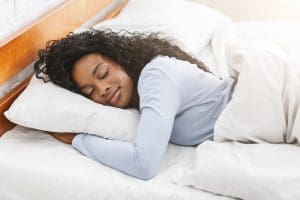 A good night’s sleep does not only depend on how long you sleep, but also the position in which you laid. There are different sleeping positions to consider depending on what your overall health goal is. Continue reading to learn what’s the best sleeping position for you.
A good night’s sleep does not only depend on how long you sleep, but also the position in which you laid. There are different sleeping positions to consider depending on what your overall health goal is. Continue reading to learn what’s the best sleeping position for you.
You know how important sleep can be to your health — seven hours a night was recently deemed the ideal in one study. But it turns out that the position you sleep in — on your side, flat on your back or prone — can also make a difference in your health and well-being. Considering that you spend a third of each day in bed, that difference could be significant.
Although the experience of individuals varies, experts say some sleeping positions may improve or prevent certain health problems. Here are the preferred ways to sleep for specific concerns.
Sleep on your side to breathe better
You (or your partner) may have noticed that snoring is worse when you are lying on your back. “It can be significant if you have untreated obstructive sleep apnea,” says neurologist Rachel Marie E. Salas, M.D., assistant medical director of the Johns Hopkins Center for Sleep and Wellness in Baltimore.
Obstructive sleep apnea happens when the tissues at the back of the throat relax and close, briefly starving you of oxygen. This leads to multiple awakenings during the night as you sputter or gasp for air. The result: fragmented sleep and fatigue.
Snuggling on your side often takes care of the snoring, but Salas recommends getting tested for sleep apnea, which is commonly treated by wearing a CPAP (continuous positive airway pressure) device. “Eighty percent of people that meet the diagnostic criteria for apnea are not diagnosed,” she says. “But it increases your risk for heart attacks, strokes, high blood pressure and heart arrythmias.” Sleep apnea is also linked to an increased risk of dementia.
Sleep on your back for back pain
If you’re one of the 80 percent of people in the U.S. who has battled back pain, the position you sleep in can mean the difference between waking restored or so stiff you want to crawl back into bed.
“Sleeping on your back in the neutral position is the gold standard,” says Shaleen Vira, assistant professor of orthopedic surgery and neurosurgery and director of spine surgery research at UT Southwestern Medical Center in Dallas. A neutral stance means maintaining the natural curves and alignment of your spine. To do that, place a pillow roll or rolled towel under your knees, and choose the “just right” bed pillow. “Sleeping with too big of a pillow will put your neck in kyphosis, meaning it’s leaning forward and causing strain,” says Vira. “And sleeping without a pillow or too small of a pillow can cause you to be hyperextended,” causing other body stresses.
Sleeping on your side — preferably with a pillow between your knees to align your back — is the next-best option, Vira says. But sleeping on your stomach, which requires you to turn your head to one side or the other to breathe, is the worst position for your spine because it flattens the natural curve of your back. It also stresses the back and neck to boot.
Sleep on your side to boost brain power
Concerned about your brain health? Side sleeping could help keep you sharp and possibly reduce your dementia risk. Here’s why: During the day, toxic byproducts of the brain’s activities accumulate in the central nervous system and are flushed away during sleep via cerebrospinal fluid, which surrounds the brain and spinal cord. The brain waste includes beta amyloid, a substance found in the brains of people with Alzheimer’s disease.
Research from the University of Rochester Medical Center (URMC) found that this waste clearance system works best when people sleep on their side, particularly the right side, says study coauthor Maiken Nedergaard, a professor of neuroscience and neurology at URMC, who discovered the brain’s cleaning system.
The reason it’s beneficial for brain clearance is that the heart helps pump cerebrospinal fluid. “The pumping of blood initiates pulsations of the blood vessel walls that drive cerebrospinal fluid into the brain,” Nedergaard explains. This process works more efficiently when people lie on their sides, boosting the cleaning process.








